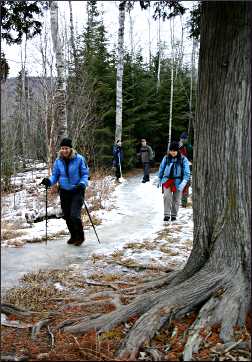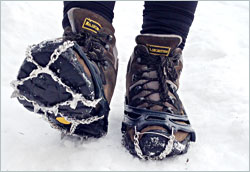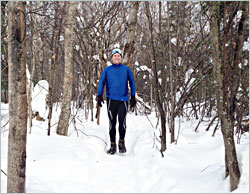Walking on ice
Even when trails are slippery, you can grip the moment with a good pair of crampons.

© Beth Gauper
One year, I declared war on ice.
You can have the finest skis, snowshoes and 4-wheel drives in the world, and you're still dead in the water when trails are covered with ice.
So for Christmas, everybody got ice grippers. I gave my husband a set whose teeth and chains made it look like S&M gear, and my son got a set with low-profile spikes that wouldn't embarrass him on walks to class. I gave myself a pair, too.
We didn't have long to wait to try them. One weekend when we were in Duluth, rain turned into ice that coated streets and trails.
Determined to enjoy the sparkling but dangerous scenery outdoors, we headed onto the Superior Hiking Trail with four different kinds of ice grippers.
What worked best? The most expensive pair . . . and the super-cheap pair.
The day before, Duluth's Hartley Park had been crowded with cross-country skiers. On the next day it was nearly empty, because skiing on icy trails is asking for broken bones.
We didn't fall. But within 10 minutes, one of my Due North Everyday Ice Creepers fell off. The little spikes did grip the ice, but snow pulled off the rubber that was supposed to grip my boot.
Luckily, I was wearing gaiters that buckled under my instep, so I just buckled in the grippers. But then the top two spikes nosed up over my boot toe, leaving only four spikes under my foot.
As I fussed with my feet, my husband was smiling rather smugly. He was wearing Kahtoola Microspikes. There was nothing micro about them, which is why they worked so well.
He was also carrying a pair of Yaktrax, which uses steel coils over rubber webbing. In Hartley Park, we passed another hiker who wore Yaktrax and said she goes through four pairs every winter.
Four pairs of those cost more than one pair of Kahtoola Microspikes — which probably is why she showed so much interest in my husband's feet. We've also seen Yaktrax lying along trails, which means they fall off easily.
Many people consider studded Icebug boots the gold standard of ice traction, because spikes are embedded right in the boot, so they'll never fall off.
Eventually, I abandoned the Due North Ice Creepers and put on the $4 crampons I'd bought years before at Ehler's General Store near the mainland ice caves of the Apostles in Wisconsin.

© Beth Gauper
They're just a claw on a strap that I buckle around my instep, but they work, and they easily fit into my pocket.
Metal snowshoes with claws work on mildly icy snow, but not on pure ice. Ski poles are handy, though. They won't grip, but they'll help you keep your balance, and they're especially useful on hills.
When choosing ice grippers, read online reviews and think about how you'll be using them. In snow, you need something that fits around most of your foot, or the snow will pull it off.
The Due North Ice Creepers might be fine on ice-glazed sidewalks, and they fold up to fit in a pocket.
But a better choice might be Stabil's Lite Walker, which grips farther up the boot, or the Lite Hiker, which attaches with a strap.
The Stabilicers Maxx attach even more securely. But I'd spend a few more bucks to get the Kahtoola microspikes.
So what if they look like an S&M toy. When you're out enjoying the scenery while everyone else is stuck at home, no one will laugh.

© Beth Gauper
Where to walk on ice
It's a mile over Lake Superior to the mainland ice caves of the Apostles on Wisconsin's Bayfield Peninsula, and then you'll want to walk into the caves, which are sheer ice.
When the lake isn't frozen, hike the clifftop Lakeshore Trail to the caves.
Take ice grippers whenever you go snowshoeing; often, a crust of ice covers trails, and it's safer to wear grippers than snowshoes.
One of the best snowshoe trails is in the western tip of the Upper Peninsula of Michigan, where there are five waterfalls along the last two miles of the Black River before it reaches Lake Superior.
I've gone snowshoeing there twice and ended up walking both times.
In northwest Wisconsin, the frozen rapids of Amnicon Falls State Park are fun to explore.
Minnesota's North Shore of Lake Superior is lined with good spots. Hikers can try any stretch of the Superior Hiking Trail.
For sightseeing and exploring, go to Artists' Point in Grand Marais and Gooseberry Falls State Park near Two Harbors.
And when winds kick up and push waves against the point at Tettegouche State Park, they create a magical ice garden.
For more, see Ice playgrounds.
Staying safe over water
Ice on lakes and rivers never is 100 percent safe. Most of us know enough to be wary of ice near the shore and ice under snow, which insulates it.
But did you know that newly formed ice usually is stronger than old ice?
For more, see the Minnesota DNR's [primer on ice safety] (https://www.dnr.state.mn.us/safety/ice/index.html).